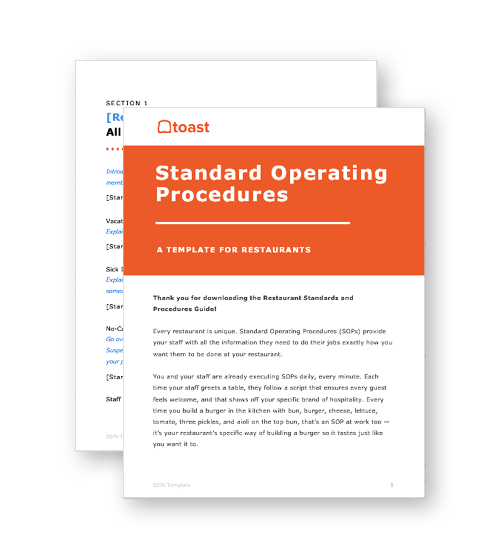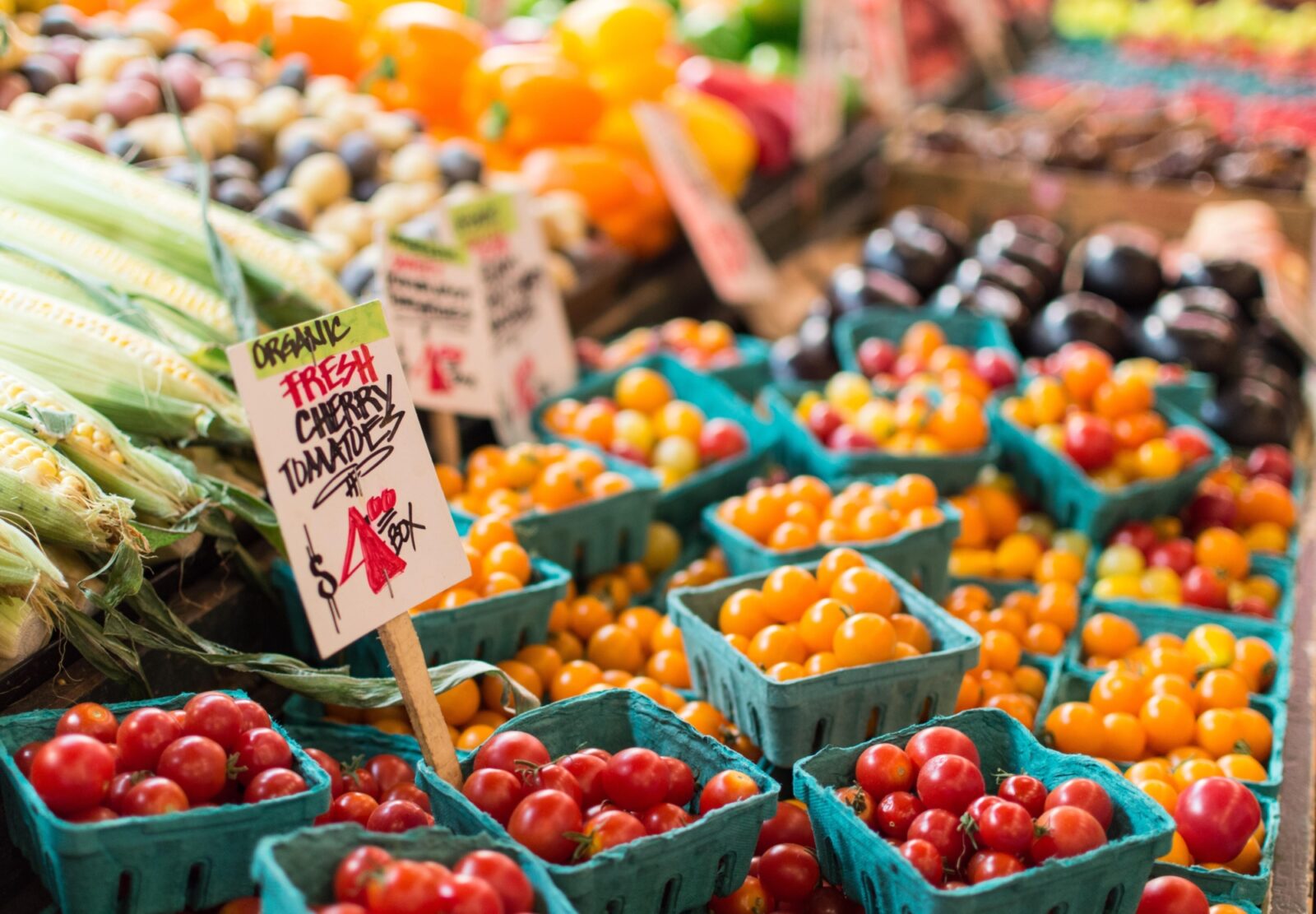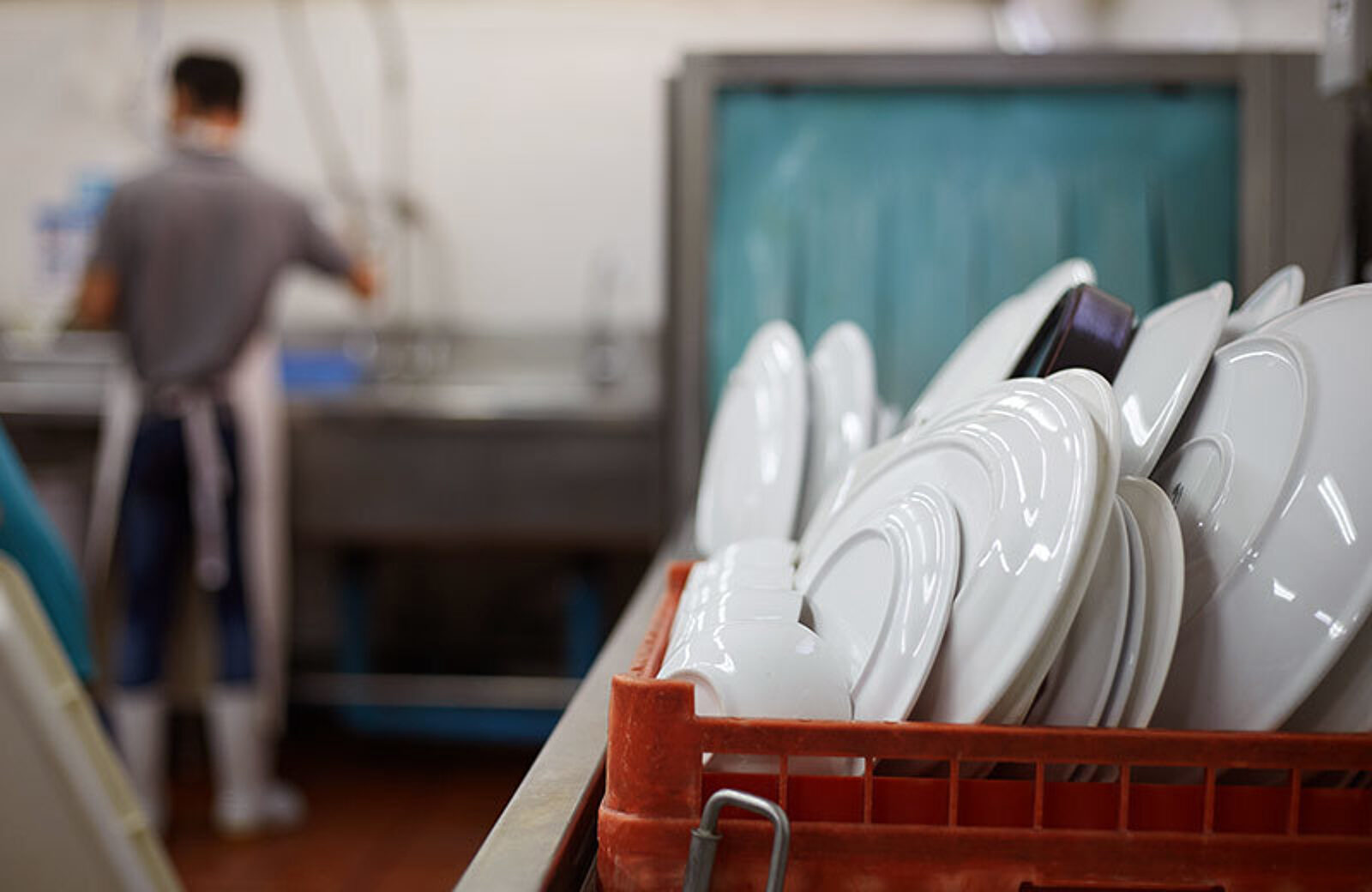
How Restaurant SOPs Improve Consistency and Your Bottom Line
Every restaurant needs clearly defined SOPs — not just franchises. Learn about how restaurant SOPs impact a restaurant business, and how to build a list of SOPs for your business.

Dahlia SnaidermanAuthor


SOPs Template
This template will help you create SOPs for your entire business, so you can create consistency and easily train employees.
Get free downloadHow SOPs Help Restaurants Run Smoothly
1. SOPs create consistency.
2. SOPs help your restaurant run itself — no matter who’s scheduled.
3. SOPs reduce food waste and boost profitability.
4. SOPs free up managers to more effectively manage staff.
5. SOPs can reduce labor costs through easy cross-training.
6. SOPs ensure that regulars stay satisfied.
Though documentation and procedure-building may not be the most exciting element of the restaurant business, it’s arguably one of the most important parts of ensuring your restaurant runs smoothly.
By documenting your repeatable processes and creating standard operating procedures (SOPs), you’ll notice greater consistency and predictability in every area of your restaurant. You’ll streamline food service, create clear safety procedures, prevent foodborne illness, reduce food waste (which boosts profitability), and create a better customer experience. Best of all, it’ll be easier than ever to thoroughly train new employees.
Chain restaurants are well-known for their SOPs, since consistency is at the core of their operations. “All crew members and managers complete training around our standard operating procedures. They are tracked for completion prior to being scheduled for that position, whether it be on the serving line, cash, expo, or grill,” explained Jacob Baxter, Equipment Innovator at Chipotle.
But SOPs aren’t just for franchises: independent restaurants can also benefit from the clarity that SOPs bring.
Restaurant Operations Manual Template
Use this free template to easily outline all of your operating procedures and make day-to-day operations as consistent as possible.

What are restaurant standard operating procedures (SOPs)?
Often referred to by the acronym SOP, a standard operating procedure is a clear, repeatable procedure for how you do a particular task in a restaurant.
Restaurants have hundreds of them. You and your staff are executing SOPs every day. For example, every time your staff greets a table, they follow a script that ensures every guest feels welcome, and that shows off your specific brand of hospitality. Every time a cook builds a burger in the kitchen with a bun, patty, cheese, lettuce, tomato, three pickles, and aioli on the top bun, that’s an SOP at work, too. It’s your restaurant’s specific way of building a burger so it looks and tastes just like you want it to.
However, SOPs are useless without great documentation, communication, training, and implementation. In many restaurants, SOPs aren’t well-documented. Instead, staff members are verbally trained to do things a certain way, but then may veer off-course and train other staff members on their preferred approach.
Well-documented SOPs give a solid backbone to your training program for new employees — and to use as a refresher for longtime employees when needed. It’s especially helpful if you’ve been dealing with staffing issues and turnover.
How to organize restaurant SOPs
There’s no one right way to organize SOPs — you could even make the case for writing an SOP about how you organize SOPs at your restaurant.
Here’s a few options for how to organize and present SOPs.
- In one big SOPs binder
- In an online document shared with each staff member as part of new hire training
- In multiple different SOP binders for different positions
- In two different SOP binders, one for front of house and one for back of house
- In conjunction with your recipe bible
- Separate from your recipe bible
- Printed as role-specific pages, laminated, and posted in a high-traffic area in the back of the restaurant
- In one big SOPs binder, with the most important SOPs printed as flyers and posted around the restaurant.
To get started, download an SOPs template like the one above, fill it in with all of your restaurant’s SOPs, and decide how you want to distribute it.
How staff input helps when building SOPs
Creating SOPs is not about making your staff into robots, or about being closed off to different ways of doing things. You’re setting standards, not making laws. Make it clear to your staff when you’re implementing new SOPs that there’s opportunity for feedback and creativity on their part.
Ask for your staff’s input when building your SOPs. See if they have a better, cheaper, or more efficient way of doing a task. After all, your servers are the ones facing hundreds of customers each night, and your cooks are the ones actually standing in front of the flattop for hours.
Get as much input as you can from as many staff members as you can when building your SOPs, and they won’t feel like rules coming from the boss, but like guidelines for success that they helped build.
Types of Restaurant SOPs
For each type of SOP, we’ll provide some examples.
Food Handling + Food Safety SOPs
Most SOPs are specific to how your specific restaurant does things. However, in the case of food safety, it’s also helpful to include industry-wide food safety rules and regulations.
- Which cutting boards correspond to various types of food? (Chicken, red meat, vegetables, fish and seafood)
- How and where are different types of food stored in the freezer and walk-in?
- How and where are different types of food defrosted?
- What temperature should refrigerators be?
- What temperature should freezers be?
- How often should fryer oil be changed?
- How often should employees wash their hands?
- The danger zone for foods is between 40°F and 140°F — how should employees cool down hot items before storing to avoid the danger zone?
- Prep areas and cutting boards must be washed and sanitized after handling and prepping foods with high risk of foodborne illness, like raw meat, chicken, seafood, and fish.
Workplace Safety SOPs
- What kind of footwear should be worn in the restaurants?
- Where is the first aid kit?
- What’s the procedure if someone sustains a serious cut or burn?
- How often should knives be sharpened to prevent cuts?
- What’s the step-by-step procedure for cleaning up major spills?
- Where are non-slip mats kept? How should they be maintained?
Food Preparation + Cooking SOPs
- How small should onions be diced?
- Which type of blender is used for the tomato sauce?
- What degree of doneness should carne asada be taken to?
- How al dente should pasta be?
Service SOPs
- What are your restaurant’s particular steps of service?
- What style of service do you offer? Elegant and formal? Warm and friendly?
- How are dining room sections assigned each shift?
- Where do bussers stand to await food coming out of the kitchen?
- What’s the maximum amount of time that food should be sitting on the pass before it’s picked up?
- What’s the procedure if a guest is behaving badly?
- What’s the procedure if a guest is intoxicated?
- What are the tip percentages built into your POS?
- Do you have a service charge?
- How do servers refill water glasses? Pour from a pitcher or take the glass and refill in the back?
Dishwashing + Cleaning SOPs
- What cleaning tasks need to be done each day?
- What cleaning tasks need to be done each week?
- Which pieces of equipment can’t go through the dishwasher?
- Which type of detergent is used?
- Who should be alerted if the dishwasher machine isn’t functioning properly?
- Where are the cleaning supplies stored?
- How should the floor be cleaned every night? With which products?
- Which products are used to clean cutting boards?
- How often are cutting boards to be sanitized?
- Where is the sanitizing solution stored?
- How often is the grease trap cleaned?
Kitchen Equipment SOPs
- How often does the oven need to be serviced?
- How should the flattop be cleaned nightly, and how often should it be deep-cleaned?
- How should staff unclog a slow-draining sink?
- Where is the vacuum stored?
Staff SOPs
Staff SOPs can sometimes overlap with your code of conduct, HR procedures, and other onboarding information found in a staff handbook. Make sure you’re always providing consistent information.
- How do staff find out which shifts they’re working?
- How do staff go about swapping shifts?
- How should staff request time off? How far in advance?
- What restaurant management style can staff expect?
- What personal hygiene standards must always be met?
How restaurant standard operating procedures make an impact on your businesses
SOPs create clear expectations, and your staff will appreciate the open communication —because there’s nothing worse than trying to figure out the right way to do something in the middle of a dinner rush.
1. SOPs create consistency
If standards and expectations haven’t been clearly outlined, it’s easy for staff to find new ways of working. This is part of why it’s helpful to involve staff from the beginning to get their input, and to stay open to requests to modify documented processes if a different approach works better in practice.
Whatever works best for your restaurant is up to you, but make sure every staff member knows which method you prefer — and make sure you write it down. When your expectations are documented, there’s no confusion, so you’ll start to see more consistency throughout your restaurant.
2. SOPs help your restaurant run itself — no matter who’s scheduled
Different staff members, and different managers, will have different strengths and skills. One cook may be a natural at organizing the walk-in, while others will be able to cook even your most intricate recipes from memory. But because not every employee will be perfect at every task automatically, keeping SOPs documented, accessible, and visible, knowledge gaps can be filled more quickly.
That means you have a better chance at procedures being followed and your business running smoothly, no matter which employees are working that day.
With a big binder full of SOPs, and with the most important ones posted as flyers around the back of house, restaurant owners can rest easy knowing that even if they’re on vacation, every employee knows how each task needs to be done.
3. SOPs reduce food waste and boost profitability
SOPs can be hugely impactful in terms of reducing costly food waste.
With SOPs in place, you can be sure that a prep cook going through employee training learns that when slicing an onion into half-moons, they should halve the onion through the root, discard the tough outer layer, and then slice all the way to the root — not leaving half an inch of onion behind. Line cooks will know to only use one half-cup ladleful of seafood stock per order of mussels, and your chef will know to only order a new box of frozen shrimp when the last one in stock has been opened.
SOPs, when properly implemented, reduce food waste, which directly helps improve restaurant profit margin.
4. SOPs free up managers to more effectively manage staff
SOPs can markedly reduce how much time your managers must dedicate to looking out for mistakes and inefficiencies. This frees them up to work on larger projects like implementing incentive programs, conducting regular check-ins with staff members, and planning skill-building workshops, which can all contribute to greater employee retention.
5. SOPs can reduce labor costs through easy cross-training
With SOPs in place, you can more easily cross-train staff on how to do everything in the restaurant — or, at least, where to look if they’re unsure. If you have to put a pasta cook on the grill station because someone called in sick, you’ll be able to give them a quick run-through of the grill station SOPs before the rush.
And if your whole BOH team knows how to work each station, and every FOH staff member can take on any role, it’s easier to run with a leaner staff on slower days, lowering labor costs.
6. SOPs ensure that regulars stay satisfied
If you were to peek into 10 different restaurant kitchens across your city, chances are you’d find 10 different ways of preparing rice, cutting carrots, and griddling a sandwich. That’s why SOPs are so helpful in the back of house: they show your staff how you want things done in your specific restaurant. Your customers come back time and time again to eat their favorite menu items, so it’s important that those items be cooked consistently and are up to par every time.
Standard operating procedures make restaurants run better
SOPs help your restaurant run like a well-oiled machine — without you having to hover over your staff. Well-documented and easy-to-reference SOPs can get you back to the part of your job you love: making sure both your staff and customers leave your restaurant happy every night.
SOPs Template
This template will help you create SOPs for your entire business, so you can create consistency and easily train employees.

Related Restaurant Operations Resources
Is this article helpful?
DISCLAIMER: This information is provided for general informational purposes only, and publication does not constitute an endorsement. Toast does not warrant the accuracy or completeness of any information, text, graphics, links, or other items contained within this content. Toast does not guarantee you will achieve any specific results if you follow any advice herein. It may be advisable for you to consult with a professional such as a lawyer, accountant, or business advisor for advice specific to your situation.
Read More
Subscribe to On the Line
Sign up to get industry intel, advice, tools, and honest takes from real people tackling their restaurants’ greatest challenges.


